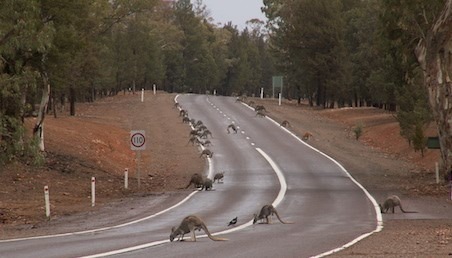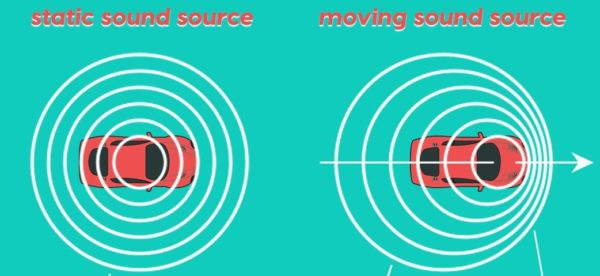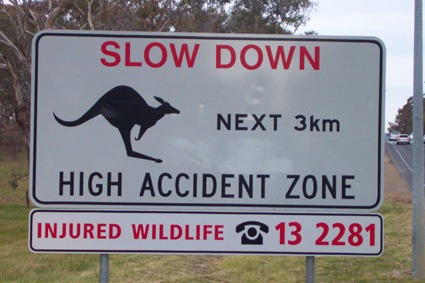Disclosure: When you click on links to various merchants on this site and make a purchase, this can result in this site earning a commission. Affiliate programs and affiliations include, but are not limited to, the eBay Partner Network
Getting ready to hit the road with our caravan, it got me wondering: do kangaroo whistles work?
I thought before I spend the money, I’d do some research. This is what I found:
No, they don’t. Tests have shown that kangaroos don’t react at all to the high frequency sounds they emit. They aren’t loud enough for the sound to project forward of a moving vehicle’s road noise… and can only be heard when the vehicle’s passing. Studies of fleets of vehicles have shown that just as many people hit kangaroos when they’re using them compared to when they’re not.
Here I’ll eplain the research I found and some tips that actually work:
Do kangaroos react to high frequency whistles?
Someone from the University of Melbourne actually did their PhD thesis on this.
Basically, the only kangaroo signal associated with alarm and flight is a low-frequency foot thump.
So their theory was that a high-frequency signal from a kangaroo whistle is unlikely have any meaning to kangaroos.
They looked at things from a few different angles, and this is what they found:
1. Even if you strap a Roo-Guard to a stake it doesn’t change kangaroo behaviour
For this part of their study they went to Melbourne Zoo and Werribee Open Range Park.
They mounted some Roo-Guards on wooden stakes and powered them by 12-Volt batteries.
Kangaroos looked towards the ROO-Guard… whether the ROO-Guard was on or off
[So it wasn’t the sound produced by the ROO-Guard that was attracting their attention]
But even if a kangaroo whistle was going off right next to where they were laying?
Nothing.
They were able to sum up that for both captive eastern grey or red kanagaroos the ROO-Guard:
- Didn’t make the kangaroos take flight, and
- Didn’t even change their behaviour
Do kangaroo whistles work even if you strap them to a pole near a kangaroo’s head?
No.

2. Driving around with kangaroo whistle doesn’t make a difference
They drove around Werribee Open Range Park with a ROO-Guard.
They drove laps… randomly having the kangaroo whistle on, sometimes with it off.
Same thing:
No change.
Do kangaroo whistles work driving around in an enclosure?
No.
Now, you could argue: but these tests are on kangaroos in a zoo or a range park… so what about the totally wild kangaroos?
3. If you leave a kangaroo whistle in the bush they’ll come and take a dump next to it
For this part of the study they strapped some ROO-Guards to stakes with batteries and solar and left them in the bush…
But first they cleared the area of kangaroo faeces.
[These people must love their job and their research]
Then they turned some on, and left others off.
And guess what?
No difference. The faecal pellet densities didn’t differ between the treatment and control sites. This suggests that no significant difference occurred in the relative density of kangaroos at sites where the ROO-Guard was on or off.
In other words…
Even if you have a kangaroo whistle on consistently, the kangaroos just ignore them and will still take a dump next to one.
Do kangaroo whistles work on free range kangaroos?
No.
How loud are kangaroo whistles?
In their study did a ton of work on the kangaroo’s hearing system. The frequencies they’re most sensitive to, and how well they can hear.
Kangaroo whistles are marketed as being able to be hear from 400 m away.
But guess what?
The average volume of kangaroo whistle (ROO-Guard) was found to be 85 decibels…
….so they could only be detected by kangaroos up to 100 m away.
This is 1/4 of the marketing claims.
But here’s something more interesting:
When a vehicle is moving the kangaroo whistle can’t be heard at any distance above a moving vehicle’s road and engine noise
Yes you can hear them as they go past… but that’s the Doppler Effect
(like how you can’t hear a race car or jet until it’s almost past you)

So if you’re travelling at 100 km/hr… the kangaroos would have 3.3 seconds to hear them them and do something about it.
Can kangaroos hear kangaroo whistles in time to do anything about them?
No.
Science aside, do kangaroo whistles work on the real word?
Research was done on fleets of vehicles where some had kangaroo whistles, otheres didn’t.
They targeted:
- Heavy trucks on interstate routes
- Buses from Melbourne to regional centres in Victoria and Southern NSW
- Ambulances and police western Victoria
- Passenger vehicles operated by two rural shire councils, and
- A rural taxi company
The vehicles travelled an average of 49,612 km.
The first bit of interesting information:
Despite the high mileage 84% of participating vehicles didn’t hit a kangaroo during the research period.
The second bit:
“There were two obvious outliers in this data set, both in vehicles fitted with a Shu Roo: one Victorian-based driver reported hitting 39 kangaroos in one night, and a Queensland-based driver reported 25 hits.”
Wow.
The third bit of interesting information:
Even when they exlcuded these two outliers, there was no difference in the proportion of vehicles with and without a Shu Roo that hit kangaroos.
Do kangaroo whistles work… at all?
No.
What can you do to avoid hitting a kangaroo?
Well, it’s important to note that this isn’t the first bit of research to say the same thing about kangaroo whistles.
There is no planned tests or data to support kangaroo whistles work (the passive ones or the powered ones).
So even if they do only cost $5-10… they’re still a waste of money.

What you can do:
1. Make sure you avoid driving at between dusk or dawn in places where there’s a lot of animals
Places like Broken Hill, Tasmania, most of the Northern Territory… the amount of roadkill is crazy.
You can’t even get insurance on a hire care if you drive it certain times of day/night in the Northern Territory.
We haven’t even come close to hitting a kangaroo on our lap of Australia because we only travelled by day.
2. Slow down so you’ve got time to brake.
The average distance you can see with your lights on low beam is 30-65 m.
If you’re travelling at 100 km/h, average stopping distance is 93 m. And if you’re travelling with a caravan, it’s A LOT more.
If you’re travelling at 100 km/h at night and you see something on the raod, it’s already too late.

So you don’t want to “outrun your lights”. If you’re running a standard light set up, you really shouldn’t be driving faster than 70 km/hr… otherwise once you see a kangaroo it’s too late.
3. Get a decent set of lights
Whether you go some HIDs or a LED Light Bar (the Kings ones are cheap on eBay)… the extra seeing distance will help give you more notice to stop in time.
If you can see 200 m, and you’re going a bt slower… then this will work better than any kangaroo whistle

![Do Kangaroo Whistles Work? [Someone Did a PhD to Find Out]](https://abigpeacheyadventure.com.au/wp-content/uploads/2019/09/Do-Kangaroo-Whistles-Work.jpg)



![17 Caravan Gift Ideas for Christmas [2021]](https://abigpeacheyadventure.com.au/wp-content/uploads/2019/11/Caravan-Gift-Ideas-Bamboo-Travel-Mugs-440x264.jpg)
Wrong wrong wrong, incorrect incorrect incorrect, bitumen driving at 50 60 km an hour sonic whistle 4.99 ,4 on car 2 font bumper 2 side near indicator ,work work work ,years of experience driving car all out back all Australia hit many many rooms,since spending $ 9 plastic sonic device nothing nothing nothing
We just bought some fixed them to car, not sure if they work but have not seen a room for awhile in a dense too area.
Sorry a roo in a dense roo area
I’ve been in two cars that have hit Roos with the cars fitted with the whistles , neither car was owned or driven by me , another car owned and driven by me but no whistle fitted when I hit a roo , luckily able to continue on my journey , I’m inclined to believe the research.
I think, what is it — a lie.
I have used them for years. I have 4 of the $6 a pair whistles attached to the front on my ute. I live in North Western NSW where the roos are often thick at dawn and dusk. I have had a roo jump into the rear indicator light once in a town area. Other than that I have never hit one. I have seen hundreds react when they apparently hear the whistles. Importantly they appear to work for birds like galahs and cockatoos. I often see them taking off as I approach about 50m to 100m in advance.
Despite the research presented above I believe they work for me in western NSW and will continue to use them. They are never a bullet proof solution, but I reckon they seem to work.